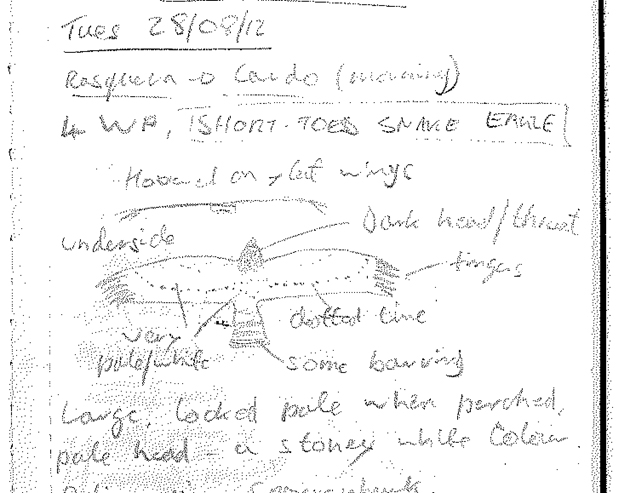Great Skua, Bridlington Bay, East Yorkshire -
Sunday 23rd September 2012 (photo: Chris Morgan)
Sunday 23rd September 2012 (photo: Chris Morgan)
Following on from my crazy birding weekend a couple of weeks previous (see here, here, here, and here), I had another one booked for the weekend of 22nd September. It didn’t quite work out as planned, but it was fun and worthwhile all the same.
I’ve been birding with my friends Mike and Chris before, but always in the company of Lee “LGRE” Evans (here and here, for example). We’d discussed having a long weekend up north (they live in London and Norfolk respectively) for a while, and decided a September weekend around Flamborough and Spurn would be ideal.
The “ideal” bit really depends on the weather, and luckily – after weeks of westerly winds – some easterlies arrived just in time for our weekend. We met up in Beverley on Friday evening and had a few gins and beers to set us up for the follow day…
Day One was all about Spurn. Well, it started out by being all about breakfast at the B&B (which was Trinity Guest House, by the way – highly recommended). This meant we were still 45 minutes away from Spurn when news of the birds started coming in.
By the time we arrived the Red-breasted Flycatcher reported near the Warren had gone to ground, but a Yellow-browed Warbler was a nice back up.
We decided to check out the high-tide wader roost from Chalk Bank. This is the point when I noticed a rattle coming from my scope as I set it up. The view through the scope was completely black and the focus wheel had become stiff. And, yes, looking through the objective lens I could see a prism rolling around inside. Arse. As I write, I’m still waiting for it to come back from repair at Opticron.
Anyway, I did get some nice views of Knot, Curlew, Grey Plover, Ringed Plover, Turnstone, Black-tailed Godwit, and Common Scoter through Mike’s lovely Swarovski scope.
Back up at Kilnsea, we hung around Beacon Lane just north of the Blue Bell, checking the bushes. Here I stumbled across a Common Whitethroat and then found a Yellow-browed Warbler (my first “self-found” for this species), which pleased me no end!
'My' Yellow-browed Warbler, Kilnsea, East Yorkshire -
Saturday 22nd September 2012 (photo: Chris Morgan)
Saturday 22nd September 2012 (photo: Chris Morgan)
We popped down to the Point and saw, apart from gulls over, only a Common Snipe, a Common Kestrel, and a great juvenile Red-backed Shrike. The Shrike gave us all the run around through the thick and prickly shrubs in the dunes, but it was worth it. The Snipe circled over our heads several times, perhaps debating internally whether it was ready to set off southwards over the sea or not.
We heard a Red-breasted Flycatcher was in the Crown and Anchor car park, and got there in good time to see not one, but two of these beauties. These flighty fellas weren’t easy to photograph, but occasionally we got some lovely views of the birds’ faces, with that trademark plaintive expression, that upright posture or those drooping wings. This was a tick for all of us, so it was handy we were in a pub car park - time for a beer in the pub.
After some sea-watching near the Warren (with Great Skua being the highlight), and seeing a nice Redstart near the Obs, we spent most of the rest of the day staring at bushes on Beacon Lane.
House Sparrow, Kilnsea, East Yorkshire -
Saturday 22nd September 2012 (photo: Chris Morgan)
Saturday 22nd September 2012 (photo: Chris Morgan)
Pied Flycatcher, Kilnsea, East Yorkshire -
Saturday 22nd September 2012 (photo: Chris Morgan)
Saturday 22nd September 2012 (photo: Chris Morgan)
We couldn’t get on the Barred Warbler that had been reported here, but we did get more views of the Yellow-browed Warbler I found earlier; plus Blackcap, loads of Pied Flycatchers, House Martins and Swallows over the fields, and a Short-eared Owl sat unobtrusively in the long grass. We took the path North, around the new Kilnsea Wetlands (four Yellow Wagtails feeding under cattle and a Carrion Crow and Kestrel face-off), before heading back to Beverley for beers and bed.
Sunset, from Kilnsea, East Yorkshire - Saturday 22nd September 2012
Day two was another trip on the Yorkshire Belle out of Bridlington. My last trip a couple of weeks back produced a stunning Pomerine Skua, and we were hoping for more of the same.
The weather was cool and overcast, but with some sunny periods. The sea was pretty calm, but there was the odd bump further out (too bumpy for some sufferers of sea sickness, unfortunately).
Highlights were 4 Sooty Shearwaters (a nice year tick, bringing this year’s list to 264), 2 Manx Shearwaters, several Great Skua and Arctic Skua (good views of both of these), a fly-past by 6 Common Scoter, and lots of close-ups of Kittiwakes.
Chris got loads of great shots, and I’m really grateful to him for letting me use them on this blog.
Sooty Shearwater, Bridlington Bay, East Yorkshire -
Sunday 23rd September 2012 (photo: Chris Morgan)
Sunday 23rd September 2012 (photo: Chris Morgan)
Manx Shearwater, Bridlington Bay, East Yorkshire -
Sunday 23rd September 2012 (photo: Chris Morgan)
Sunday 23rd September 2012 (photo: Chris Morgan)
Arctic Skua, Bridlington Bay, East Yorkshire -
Sunday 23rd September 2012 (photo: Chris Morgan)
Sunday 23rd September 2012 (photo: Chris Morgan)
Kittiwake, Bridlington Bay, East Yorkshire -
Sunday 23rd September 2012 (photo: Chris Morgan)
Sunday 23rd September 2012 (photo: Chris Morgan)


















































